A teacher showed students an example and explained the usage of past perfect tense, and ask students to list ten “past perfect tense” sentences by imitating that example. What’s teacher's grammar teaching method?A.Consolidation. B.Presentation. C.Deductio
题目
A teacher showed students an example and explained the usage of past perfect tense, and ask students to list ten “past perfect tense” sentences by imitating that example. What’s teacher's grammar teaching method?
A.Consolidation.
B.Presentation.
C.Deduction.
D.Induction.
B.Presentation.
C.Deduction.
D.Induction.
相似考题
更多“A teacher showed students an example and explained the usage of past perfect tense, and ask students to list ten “past perfect tense” sentences by imitating that example. What’s teacher's grammar tea”相关问题
-
第1题:
A teacher showed students an example and explained the usage of past perfect tense, and asked students to list ten"past perfect tense" sentences by imitating that example. What's the teacher' s grammar teaching method?A.Consolidation.
B.Presentation.
C.Deduction.
D.Induction.答案:C解析:考查语法教学知识。教师通过一个例子讲了语法过去完成时的用法,然后让学生模仿此例子造十个过去完成时的句子,是典型的“演绎”教学法。consolidation意为“巩固”,presentation意为“呈现”,deduction意为“演绎”,induction意为“归纳”。 -
第2题:
When a student said “All the classes will be finished before December 7th, and then students have exams”, the teacher didn't stop him to correct the tense mistake, but let him keep talking. What can we conclude from this activity?A.The teacher combined listening and speaking skills.
B.The teacher focuses on fluency.
C.The teacher is doing contextualized practice.
D.The teacher is using different speaking activities.答案:B解析:考查口语技能教学
题目说的是一个学生说“All the classes will be finished before December 7th, and then students have exams”,老师没有更正他的时态错误,而是让他继续说下去,从这个活动中我们可以看得出什么?
B选项,是这位老师注重流利性原则,所以不打断这位同学说话,老师没有纠错而是让他继续说,这是对流利性原则的使用。符合题意,故此题的正确选项为B。
A选项,是这位老师结合了听力和口语教学,不合题意,故排除。
C选项,是这位老师正在进行上下文练习,不合题意,故排除。
D选项,是这位老师正在使用不同的口语练习活动,不合题意,故排除。
故此题的正确选项为B。 -
第3题:
What's the teacher doing by saying "Who wants to have a try"?A. Controlling discipline.
B. Giving prompt.
C. Evaluating students' work.
D. Directing students' attention to the lesson.答案:B解析:考查课堂提问的作用。教师问“谁想试一试”,对课堂活动起到促进作用,故选B。 -
第4题:
A teacher handed out a list of twenty "Future tense"sentences and asked students to discuss and find out the grammatical structures. What is the teacher's grammar teaching method?A.Induction.
B.Presentation.
C.Consolidation.
D.Deduction.答案:A解析:考查语法教学。题目问的是:一位老师列出了二十个与将来时相关的句子,然后请学生讨论并找出将来时的语法结构,这位老师使用了哪种语法教学方法 语法教学的常用方法有两种:演绎法和归纳法。A项的Induction是归纳法;D项的Deduction是演绎法。本题中的教学方法很明显是归纳法。B项的新课展示和C项的巩固提高,都是教学环节,不是教学方法。因此选A项。 -
第5题:
A teacher showed students an example and explained the usage of past perfect tense,and ask students to listen“past perfect tense”sentences by imitating that example.What’s teacher's grammar teaching method?A.Consolidation.
B.Presentation.
C.Deduction.
D.Induction.答案:C解析:考查语法教学知识。
题干的意思:老师给学生展示例子和解释过去完成时的用法,让学生模仿例子列出十个过去完成时的句子,老师用的是什么教学方法?
C项,演绎法法,符合题意,故此题的正确选项为C。
A项,巩固;B项,新授;C项,归纳法,和演绎法相反;均不合题意,故排除。
故此题的正确选项为C。 -
第6题:

二、考题解析
【教案】
Teaching aims:
Knowledge aims:
Students will know how to describe a day using proper conjunctions and tense.
Students will master some words, such as waste, value... and a sentence structure: I usually + simple present tense.
Ability aim:
Students will improve their abilities of speaking and listening.
Emotional aim:
Students will be more confident in speaking English.
Key and difficult point:
Key Point: Students will know how to introduce a day in English.
Difficult Point: Students will use the sentence structure in real communicative situation.
Teaching procedure:
Step 1: Warming-up
1. Greetings.
2. Play a video about Tom’s day and ask students what kind of information have they caught.
Step 2: Pre-listening
1. Review the knowledge about simple present tense. Ask students to make sentences using simple present tense.
2.Using pictures to explain some words: waste-value, brush.
Step 3: While-listening
1st listening: Ask students to listen to the tape for the first time and try to get the main idea of the passage and underline the conjunctions used.
2nd listening: Ask students to listen to the tape for the second time and complete the timetable below.
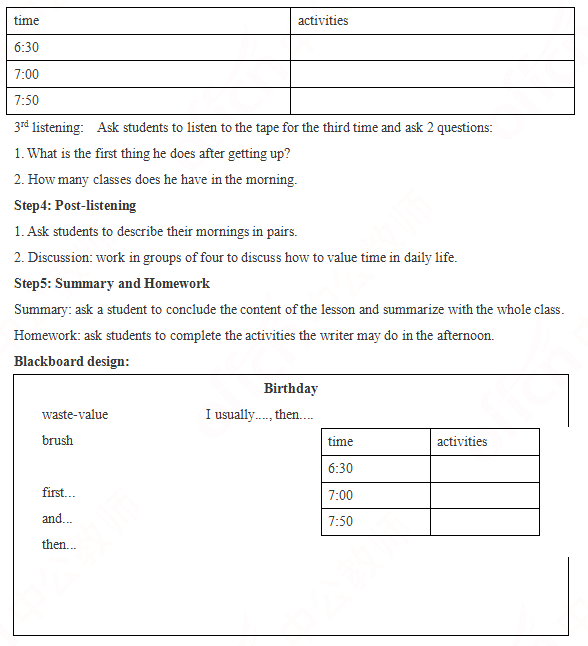 答案:解析:暂无解析
答案:解析:暂无解析 -
第7题:
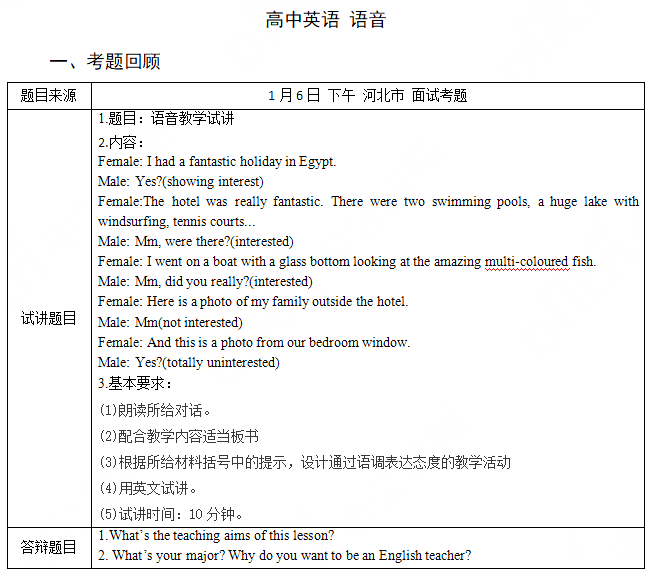
二、考题解析
【教案】
Teaching aims:
Knowledge aim:
Students can master the intonation of showing their attitudes.
Ability aim:
After this lesson, students can practice their listening and speaking ability through group work.
Emotional aim:
Students are able to love learning English after this lesson.
Key and difficult point:
Key Point: master the intonation of showing their attitudes.
Difficult Point: cultivate the interest of students’ learning English.
Teaching procedures:
Step 1: Warming-up
1. Greetings.
2. Play a video about a person who is shopping at a store and has a conversation with the shop assistant. And ask students to answer some questions: Does this customer want to buy the clothes? Give the reason
Step 2: Presentation
1.Ask students to listen the conversation carefully and the teacher reads the conversation that today needs to learn and ask students:
Which part does the male show the interest? Give the reason
And which part does the male show the uninterested? Give the reason
2.Then present the conversation on the PPT, and ask students to listen to the conversation again, pay attention to the intonation of male’s answers. And ask students to answer some questions:
When male shows the interest to the content of female’s saying, what kind of intonation does he use? Uninterested, what’s intonation?
3. Then lead the students to conclude the rules of intonations of showing their attitudes. At the same time, write the male’s words on the blackboard with the help of symbols of rising tone and falling tone.
Step 3: Practice
1.Ask students to read this conversation after the tape.
2.Role-play: Ask students to practice this conversation with their partner and after 5 minutes, invite some students to read this conversation for all the students.
3. Dubbing: Ask students to look at a short video about a conversation between a Chinese student and another foreign student. But this video only has the frames, but doesn’t have the sound, which needs students to finish dubbing with their deskmates in given 10 minutes. Then invite several students to show their conversation with all the students.
Step4: Production
Make stories: Ask students to use the knowledge of intonation to make a short story according to the chart. Before this, divide the students into several groups with different persons and ask the representatives to get their topic through the way of random draw.
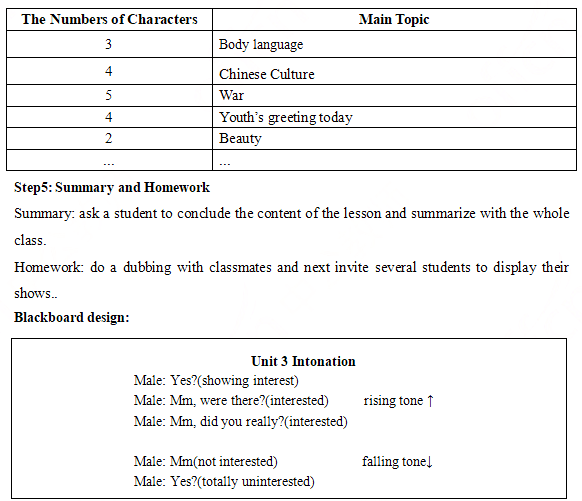
1.What’s the teaching aims of this lesson?
2. What’s your major? Why do you want to be an English teacher?答案:解析:1.
There are three aims: knowledge aim,ability aim and emotional aim.
Knowledge aim:
Students can master the intonation of showing their attitudes.
Ability aim:
After this lesson, students can practice their listening and speaking ability through group work.
Emotional aim:
Students are able to love learning English after this lesson.
2.
My major is medicine. But I like English. And my biggest hobby is learning and speaking English. In my daily life, I like to go abroad to travel and reading English novels. I think English is more useful and attracting for me than my major, medicine. -
第8题:
初中英语?语法
一、考题回顾
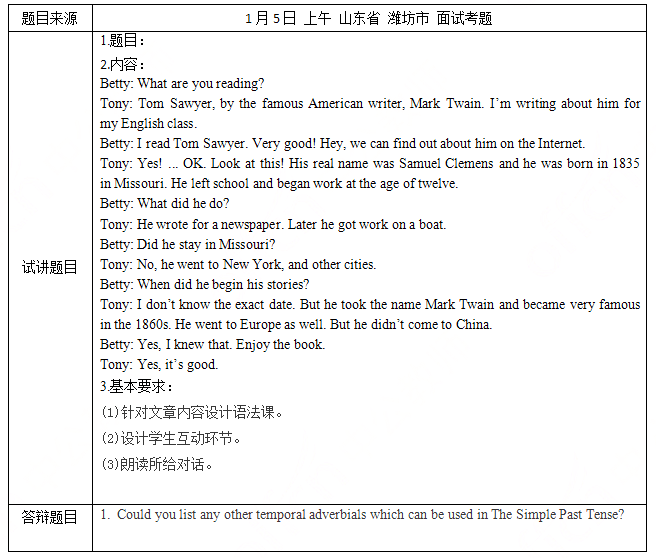
二、考题解析
【教案】
Teaching aims:
Knowledge aim:
Students will master the rule of the Simple Past Tense.
Ability aim:
Students will able to talk about the things happened in the past in their daily life.
Emotional aim:
Students will learn how to cooperate with others.
Key and difficult point:
Key Point: Students will master the structure of the Simple Past Tense.
Difficult Point: Students will use the structure of the Simple Past Tense in daily life.
Teaching procedure:
Step 1: Warming-up
1. Greetings.
2. Ask students a question: what are you reading recently? And ask some students to share with the whole class.
Step 2: Presentation
1. Review the knowledge about the past tense of verbs: write some verbs on the blackboard and ask students to change the verbs into their past tense.
2. Ask students to read the dialogue and pay attention to the background information about Mark Twain. Then ask students some questions: What’ Mark Twain’ real name? When did he born? When did he begin to work? And then invite some students to share the answers with the whole class and write down on the blackboard.
3. Then ask students when these things happened and then tell them the rule of past tense: Simple Past Tense refers to the actions or states happened at a certain moment in the past, or a certain period of time in the past. It is often used with temporal adverbial, such as yesterday, last week and so on.
4. Ask students to read the dialogue again and try to find other sentences which used the Simple Past Tense and share with class. Then tell students the rule of general and special interrogative sentences in the past tense: general interrogative sentences use auxiliary verbs (did) and special interrogative sentences use special interrogative words (what, when, how...).
Step 3: Practice
1. Ask student to role play the dialogue and ask two groups to show in class.
2. Play a game: magic box. There is a magic box which is full of all kind of verbs, ask students to choose one card and then make a sentence with it using the Simple Past Tense.
Step4: Production
Discussion: ask students to talk about what happened to them in the last weekend, they should use the Simple Past Tense and then invite two of them to show their conversation.4 in 1, 5 minutes will be given.
Step5: Summary and Homework
Summary: ask a student to conclude the content of the lesson and summarize with the whole class.
Homework: ask students to practice the usage of Simple Past Tense learned today with desk mates after class.
Blackboard design:
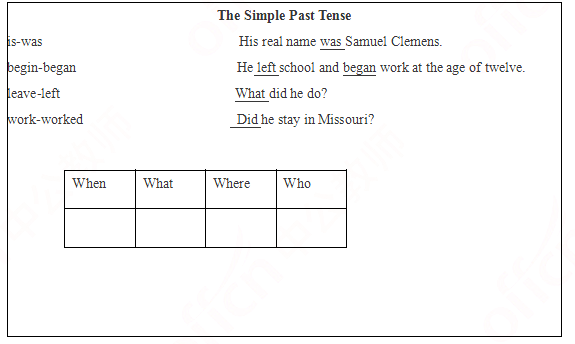
1. Could you list any other temporal adverbials which can be used in The Simple Past Tense?答案:解析:Usually, we can use yesterday, last night/night/month/weekend/year, the day before yesterday, in 1992 (a year in the past), in the 1990s, at the age of 16 and so on. -
第9题:
What the element ‘-es’ indicates is third person singular, present tense, the element ‘-ed’ past tense, and ‘-ing’ progressive aspect. Since they are the smallest unit of language and meaningful, they are also().
Aphonemes
Bmorphemes
Callophones
Dphones
B
略 -
第10题:
单选题A teacher lists twenty" simple present tense" sentences and asks students to discuss and find out the grammatical structures. What's the teacher's grammar teaching method?AInduction.
BConduction.
CConstruction.
DDeduction.
正确答案: C解析: -
第11题:
单选题What’s the teacher doing by saying “Who wants to have a try”? _____AControlling discipline.
BGiving prompt.
CEvaluating students’ work.
DDirecting students’ attention to the lesson.
正确答案: C解析:
教师在此充当课堂教学的推动者,鼓励学生参与课堂活动。 -
第12题:
单选题A teacher lists twentysimple present tensesentences and asks students to discuss and find out the grammatical structures. What's the teacher's grammar teaching method?AInduction.
BConduction.
CConstruction.
DDeduction.
正确答案: B解析: -
第13题:
What stage can the following grammar activity be used at
The teacher asked students to arrange the words of sentences into different columns raarked subject, predicate, object, object complement, adverbial and so on.
A. Presentation.
B. Practice.
C. Production.
D. Preparation.答案:B解析:考查语法教学内容。做句子成分分析常用于语法练习阶段。故选B。 -
第14题:
A teacher handed out a list of twenty"Fature tense" sentences and asked students to discuss and find out the grammatical structures. What is the teacher's grammar teaching method?A.Induction.
B.Presentation.
C.Consolidation.
D.Deduction.答案:A解析:考查语法教学。题目问的是:一位老师列出了二十个与将来时相关的句子.然后请学生讨论并找出将来时的语法结构,这位老师使用了哪种语法教学方法 语法教学的常用方法有两种:演绎法和归纳法。A项的Induction是归纳法;D项的Deduetion是演绎法。本题中的教学方法很明显是归纳法。B项的新课展示和C项的巩固提高.都是教学环节,不是教学方法。因此选A项. -
第15题:
What stage can the following grammar activity be used at?
The teacher asked students to arrange the words of sentences into different columns raarked subject, predicate, object, object complement, adverbial and so on.A. Presentation.
B. Practice.
C. Production.
D. Preparation.答案:B解析:考查语法教学内容。做句子成分分析常用于语法练习阶段。故选B。 -
第16题:
A teacher handed out a list of twenty"Fature tense" sentences and asked students to discuss and find out the grammatical structures. What is the teacher's grammar teaching method?A. Induction.
B. Presentation.
C. Consolidation.
D. Deduction.答案:A解析:考查语法教学。题目问的是:一位老师列出了二十个与将来时相关的句子.然后请学生讨论并找出将来时的语法结构,这位老师使用了哪种语法教学方法?语法教学的常用方法有两种:演绎法和归纳法。A项的Induction是归纳法;D项的Deduction是演绎法。本题中的教学方法很明显是归纳法。B项的新课展示和C项的巩固提高.都是教学环节,不是教学方法。因此选A项. -
第17题:
小学英语?语法
一、考题回顾

二、考题解析
【教案】
Teaching aims:
Knowledge aim:
Students will grasp the usage of simple past tense.
Ability aim:
Students will improve their speaking ability in describing things happened in the past.
Emotional aim:
Students will be more confident in speaking English.
Students will arouse their interest in learning oral English.
Key and difficult point:
Key Point:
Students will grasp the usage of simple past tense.
Students will improve their speaking ability in describing things happened in the past.
Difficult Point:
Students will be more confident in speaking English.
Students will arouse their interest in learning oral English.
Teaching procedure:
Step 1: Warming-up
1. Greetings. Talk about the weather.
2. Sing a song called Yesterday Once More, and introduce today’s topic.
Step 2: Presentation
1. Read the dialogue by the teacher, and ask what the dialogue is about.
2. Let the students open the book and read it for the second time, then ask the students to circle the verb in it and ask the similarities among them. They may say that they are different from the verbs they learned. “-ed” is added in some verbs at the end.
3. Tell them that simple past tense is a tense that is used to describe things happened in the past. When we apply it, you should change the verb into past tense. Then introduce the regular and irregular verbs.
Step 3: Practice
1. Fill in the blanks.
a. I _____(clean) the table after we had lunch last evening.
b. My father_____(go) to the company yesterday.
Step 4: Production
1. Make a dialogue with their deskmates about what the students did last weekend. Then invite some students to share their dialogue with their parents.
2. Ask the students to make up a simple story or a joke. Then invite some students to share it with us.
Step5: Summary and Homework
Summary: make a brief summary of what we have learned today.
Homework: Tell the story or the joke to their parents.
Blackboard design:

1. Please talk about your understanding of simple past tense.
2. How do you stimulate students’ interest in learning grammar?答案:解析:1.
Simple past tense is a tense used to describe things happened in the past. When we use it, we need to change the verb into past tense. The verbs are changed in regular form or regular form. Regular verb only needs to add -ed at the end of a word, while irregular verbs have various forms. I will now show an example: My friend looked at me when I touched him. So that’s my understanding of simple past tense.
2.
Grammar can be a little boring for students. But it is essential to learn English. So different activities can be arranged to attract their attention. For example, in the warming-up, I sang a song called Yesterday Once More so that they will know this grammar point is around us and frequently used. Then, in the presentation part, I will let the students take the initiative to find the rules of simple past tense. At last, I asked students to talk about their daily lives and share stories or jokes with simple past tense, so they will use the tense and do not get bored with much mechanical drilling. So I believe they will be interested in my grammar lesson. -
第18题:
高中英语?语法
一、考题回顾
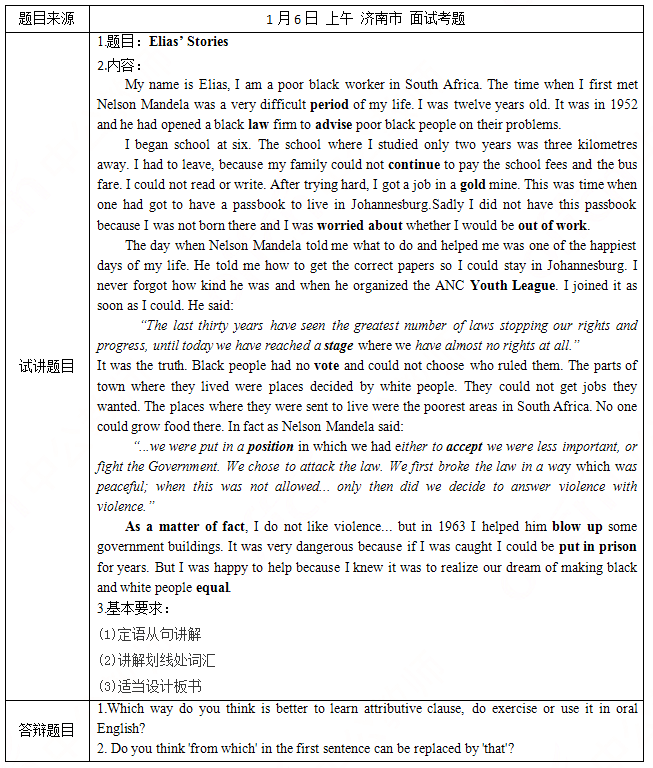
二、考题解析
【教案】
Teaching aims:
Knowledge aims:
(1)Students are able to master the meaning of bold words and phrases: period, law, advise, gold, worried about, out of work, Youth League, stage, stage, position, as a matter of fact, blow up, put in prison, equal
(2)Students can master the usage of adverb in attributive clause.
(3)After this lesson, students can know the difference of usage of adverb in attributive clause and the usage of pronoun in attributive clause.
Ability aim:
After this lesson, students can use grammar of attributive clause in reading and writing.
Emotional aim:
Students are able to love learning English after this lesson.
Key and difficult point:
Key Point: master the meaning of words and phrases :period, law, advise,gold,worried about etc.
Difficult Point: use grammar of attributive clause in reading and writing
Teaching procedures:
Step 1: Warming-up
1. Greetings.
2. Ask students to make several sentences using the grammar of usage of pronoun in attributive clause. Then write a sentence needing to use adverb in attributive clause. And then lead in the new grammar, adverb in attributive clause.
Step 2: Presentation
1.Ask students to open the book and read the passage to guess the meaning the bold words and then paraphrase the bold words with the help of PPT.
2. Then Ask students to find out more complex sentences that the clause is after a noun or pronoun and the words that are used to introduce the sentences: where, when, why or preposition plus which.
The time( when I first met Nelson Mandela )was a very difficult period of my life.
The school (where I studied only two years) was three kilometres away.
This was time (when one had got to have a passbook )to live in Johannesburg.
we were put in a position (in which we had either to accept we were less important, or fight the Government). ...
Then ask students to find the similarity of these sentences and invite several students to share their ideas. Then lead the students to conclude the rules of relative adverb in attributive clause and preposition plus which in attributive clause. (They all function as adverbials)
Step 3: Practice
1.Make sentences: Ask students to use the grammar that has just learnt to describe the pictures which are presented on the PPT.
2.Combine the sentences: Ask students to combine the sentences according to the grammar in attributive clause.
(1)This is a book. Its cover is blue. (whose)
(2)He is the teacher. He helped me. (who/that)
(3)Beijing is the place. I was born in this place. (where/ in which)
(4)This is the hotel. You will stay at the hotel. (where/at which)
Step4: Production
1.Make stories: Ask students to use the grammar that has just learnt to describe the video.
2.Discussion: Ask students to tell their daily life to use the grammar that has just learnt. And after 5minutes to invite several students to share their daily life.
Step5: Summary and Homework
Summary: ask a student to conclude the content of the lesson and summarize with the whole class.
Homework: write a short passage about his daily life using the grammar that has just learnt.
Blackboard design:
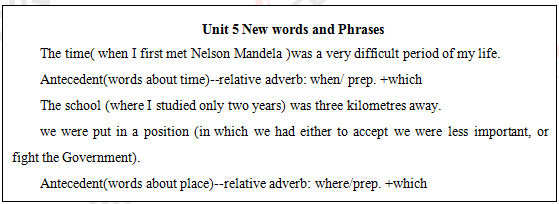
1.Which way do you think is better to learn attributive clause, do exercise or use it in oral English?
2. Do you think 'from which' in the first sentence can be replaced by 'that'?答案:解析:1.
(1)I think, first, the best way to learn attributive clause is tell the definition of this grammar in
sentence. For example, this is a beautiful teacher (who wears the red dress )is our teacher. Then ask students to pay attention to the clause to find the features of this sentence and conclude the attributive clause: noun/pronoun plus a whole sentence. Next tell the usage of pronoun in attributive clause. Last, teach the usage of adverb in attributive clause.
(2) Exercise and oral English should use togerther in practice attributive clasue. Doing exercise can make students master the structure of this grammar easily. And oral English can make students know the real situation of attributive clause in our daily life.
2.
No, I don’t think. From which is an relative adverb from the point of grammar. And that belongs to the pronoun. So it only can be used as the subject, object and so on but can not be used as the adverb or as as phrase. And this sentence doesn’t have the adverb, so we must use from which. -
第19题:
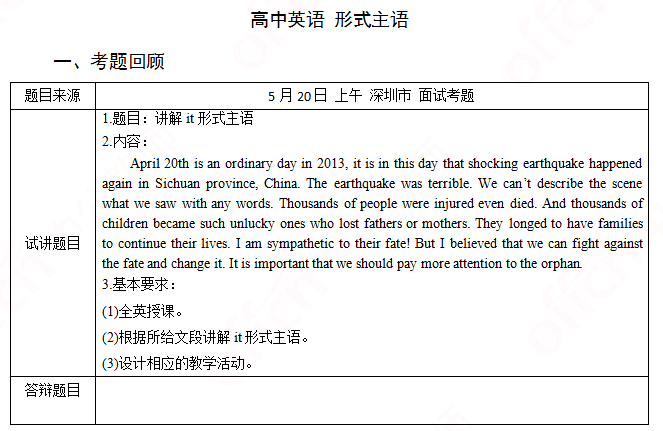
二、考题解析
【教案】
Teaching aims:
Knowledge aim: Students can master the usage of formal subject.
Ability aim: Students can use formal subject to communicate in their daily life.
Emotional aim: Students can enhance their interest in learning English.
Key and difficult point: Students can use formal subject to communicate in their daily life.
Teaching procedure:
Step 1: Warming-up
The teacher plays a documentary video about the earthquake in Wenchuan. Then asks students to talk about their feelings after watching. And lead in the topic.
Step 2: Presentation
The teacher lets students to read the passage and get the main idea. Then the teacher picks the last sentence out. The teacher will use the sentence as example to explain the structure and usage of formal subject.
Step 3: Practice
After explaining, the teacher will show some normal sentences. Students should transfer them into formal subject structure.
For example: Taking good care of the orphans is very important.
→It is very important to take good care of the orphans.
Step4: Production
The teacher lets students talk with their deskmates. They should come up with some ways to help the orphans. Then invites some students to show their opinions.
Step5: Summary and Homework
The teacher summarizes what they have learnt today. Then after class, students could say something to these orphans and take a video. The teacher will help them sent it to the orphan.
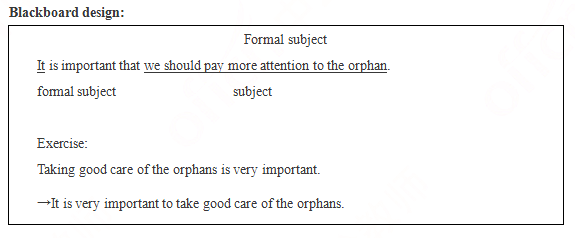
答案:解析:暂无解析 -
第20题:
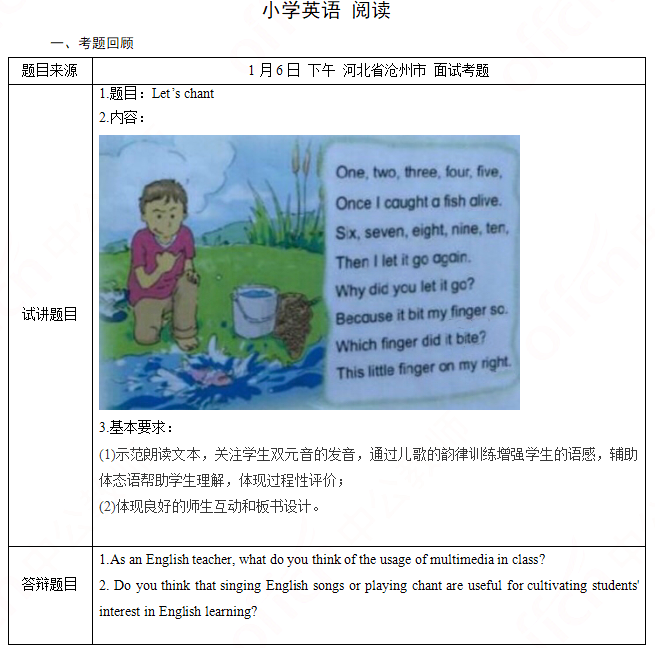
二、考题解析
【教案】
Teaching aims:
Knowledge aim:
Students will master the sound /ai/ in the words “five”, “alive” and so on.
Ability aim:
Students will apply the sound correctly in real communication.
Emotional aim:
Students will be more interest in speaking English.
Key and difficult point:
Key Point: Students will master the sound /ai/ in the words “five”, “alive” and so on.
Difficult Point: Students will apply the sound correctly in real communication.
Teaching procedure:
Step 1: Warming-up
1. Greetings.
2.Play a chant they have learned “tomato, tomato, wash, wash, wash” and lead them to learn another chant this class..
Step 2: Presentation
1. Students watch the picture and tell the teacher what they can see in the picture, and the teacher guide them to present the first part of the chant. Then students watch the picture carefully and predict what’s wrong with the boy, then the teacher guide them to present the last part of the chant.
2. Students observe the sentences and find out what common letters they can find.
3. The teacher teaches them correct pronunciation of the letter “i” in “five”, “right” and so on.
Step 3: Practice
1. Read the pronunciation /ai/ and the words that includes “i” repeatedly.
2. Listen to the tape and follow the tape, paying attention to the intonation of the chant.
3. Students work in pairs to make a chant in 5 minutes.
Step4: Production
1. The teacher writes more words that includes the sound /ai/and students try to read them.
2. Students work in groups to make a story using the picture and the words with the sound /ai/ on the blackboard.
Step5: Summary and Homework
Summary: ask a student to conclude the content of the lesson and summarize with the whole class.
Homework: ask students to search other pronunciation of the letter “i” and list those words accordingly.
Blackboard design:

1. As an English teacher, what do you think of the usage of multimedia in class?
2. Do you think that singing English songs or playing chant are useful for cultivating students' interest in English learning?答案:解析:1.
Multimedia help students to understand our class more smoothly and vividly and enhance their thinking ability. With images, audios and videos, knowledge that is difficult to understand in English is well presented. The students can more truly feel the content of the text, which is helpful to solve difficulties. In the environment of multimedia students can also develop abstract thinking and divergent thinking.
2.
As far as the activity such as singing or chant itself is concerned, it is very interesting and can attract students' attention. The time for students to keep concentrating is limited. If you add such activities as some songs and chants that students like, you can not only attract students' attention, but also cultivate their interest in learning. Therefore, combining knowledge and activities in the classroom allows students to learn while playing and even achieve better effects. -
第21题:
单选题Think about when a teacher handed out a list of twenty Past tense sentences and asked students to discuss and find out the grammatical structures. What is the teacher's grammar teaching method?AInduction.
BPresentation.
CConsolidation.
DDeduction.
正确答案: A解析: -
第22题:
单选题What stage can the following grammar activity be used at?The teacher asked students to arrange the words of sentences into different columns marked subject, predicate, object, object complement, adverbial and so on.APresentation.
BPractice.
CProduction.
DPreparation.
正确答案: A解析: -
第23题:
单选题What stage can the following grammar activity be used at? The teacher askes students to arrange the words of sentences into different columns marked subject, predicate, object, object complement, adverbial and so on. _____APresentation
BPractice
CProduction
DPreparation
正确答案: D解析:
对句子成分进行分析是语法练习阶段。
